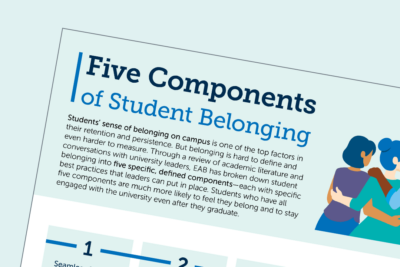How to improve your emotional support animal process
Campuses are seeing a rise in accommodation requests for emotional support animals (ESAs). Also called assistance, companion, or comfort animals, ESAs are animals that provide their caretakers with comfort and relief from the impacts of mental health disabilities by virtue of the animal’s nature and presence. As frequency of requests continues to increase, colleges and universities must create new comprehensive policies or make changes to improve your emotional support animal process already in place.
Institutions are committed to facilitating access to students with disabilities, but ESA accommodations can be complex. EAB reviewed 100+ policies and procedures to identify best practice solutions to common challenges institutions encounter when accommodating ESA requests on campus. Use this infographic to learn what tactics colleges and universities are using to clarify and streamline their ESA processes, from application to arrival on campus.
Your ESA to-do list
As the volume and complexity of these requests increase, there are five priorities that should be on every institution’s to-do list.
- Educate colleagues and campus partners about Emotional Support Animals and their presence on campus. Use EAB’s ESA issue brief to get everyone on the same page.
- Define and communicate a policy for emotional support animals, ideally one that is distinct from a service animal policy. Use our ESA policy template to audit your current policy or inform creation of your campuses policy.
- Design an application appeal process that efficiently and reasonably solicits the information you need to determine the reasonableness of the accommodation request.
- Articulate and communicate the responsibilities and expectations of students with emotional support animal accommodations.
- Define the post-accommodation approval process and logistics for both campus and the student.
More Resources

Student Experience and Well-being Resource Center

5 components of student belonging

